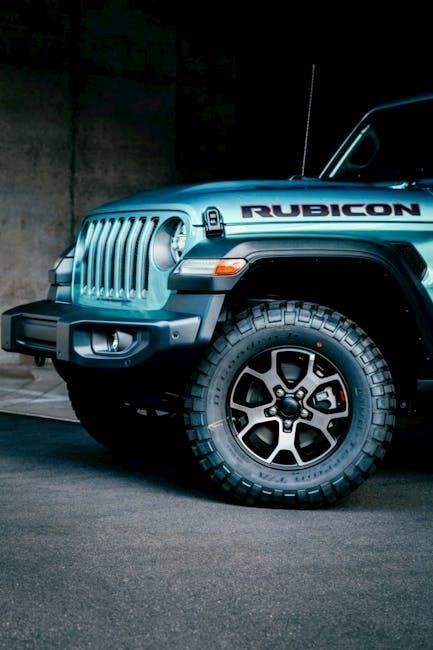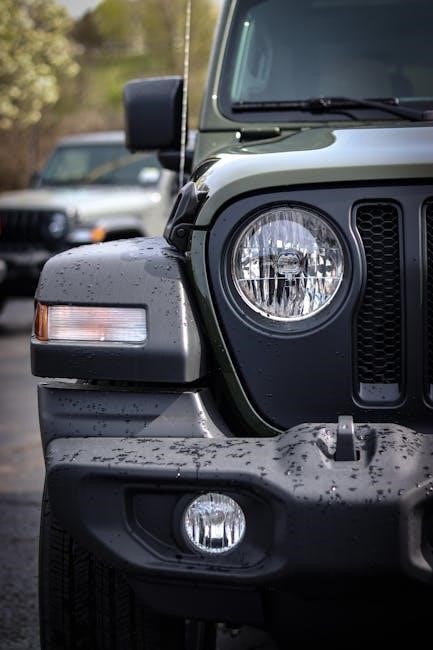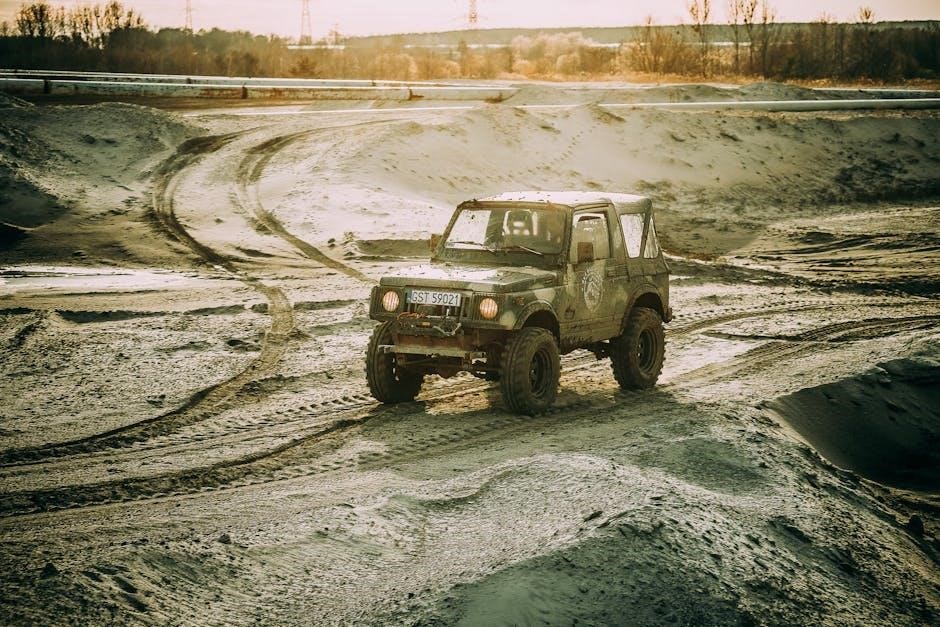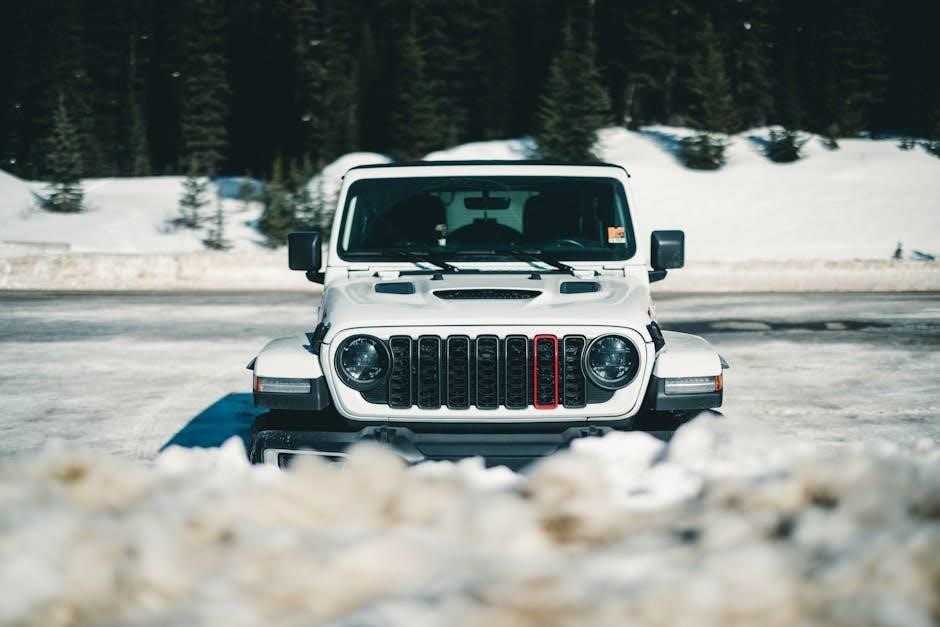Welcome to the official Jeep Wrangler Instruction Manual. This guide provides essential information on features, operation, and maintenance to ensure safe and optimal use of your vehicle.
1.1 Purpose of the Manual
The purpose of this manual is to provide Jeep Wrangler owners with comprehensive information on vehicle operation, maintenance, and safety. It guides users through understanding features, troubleshooting, and customizing their vehicle. The manual ensures safe and optimal use, covering essential topics like driving tips, maintenance schedules, and emergency procedures. By following this guide, owners can maximize their Jeep Wrangler’s performance and longevity while ensuring a secure driving experience.
1.2 How to Use This Manual
This manual is designed to help you understand and make the most of your Jeep Wrangler. Start by reviewing the table of contents to locate specific topics. Sections are organized to cover essential areas like safety, maintenance, and operation. Use the index for quick reference. Always read warning labels and cautions to ensure safe practices. Refer to the manual regularly for troubleshooting, customization, and proper vehicle care to maximize performance and longevity.
1.3 Important Safety Information
Always prioritize safety while operating your Jeep Wrangler. Read and follow all warnings, cautions, and guidelines in this manual. Wear seat belts at all times, and ensure all passengers do the same. Be aware of rollover risks, especially during sharp turns or off-road driving. Familiarize yourself with warning lights and messages on the instrument panel. Never modify your vehicle in ways that compromise safety features. Regularly inspect tires, brakes, and suspension for optimal performance. Follow recommended load limits to avoid overloading the vehicle.

Getting to Know Your Vehicle
Explore your Jeep Wrangler’s unique features and capabilities. This section guides you through exterior, interior, and instrument panel details to enhance your driving experience.
2.1 Exterior Features
The Jeep Wrangler boasts a rugged and versatile exterior design. Features include removable tops, foldable windshields, and interchangeable doors for customization. The durable construction ensures off-road readiness, with high ground clearance and skid plates for protection. Exterior elements like door handles, mirrors, and tire options enhance functionality. The iconic grille and round headlights embody the classic Jeep aesthetic, while modern touches like LED lighting provide improved visibility. These features blend tradition with innovation, making the Wrangler adaptable to any adventure.
2.2 Interior Features
The Jeep Wrangler interior is designed for comfort and functionality. Features include ergonomic seating, adjustable steering wheels, and intuitive controls. The dashboard houses essential gauges and multimedia systems, while storage compartments provide practicality. Available upgrades like heated seats and premium materials enhance comfort. The interior is tailored for both daily driving and off-road adventures, ensuring versatility and convenience. These features ensure a balanced blend of ruggedness and modern amenities, catering to diverse driver needs and preferences.
2.3 Instrument Panel Overview
The instrument panel in your Jeep Wrangler is designed to provide clear and essential information at a glance. It features a speedometer, tachometer, fuel gauge, and warning lights for system status. Red warning lights indicate critical issues like low oil pressure or high engine temperature, while yellow lights alert for less urgent matters. Green and blue indicators show features like high beams or cruise control. The panel also includes customizable settings to tailor the display to your preferences, ensuring a seamless driving experience.

Safety Features and Precautions
Your Jeep Wrangler is equipped with advanced safety features, including seat belts, airbags, and rollover protection. Always wear a seatbelt and follow precautions to minimize risks during operation.
3.1 Seat Belts and Airbags
Your Jeep Wrangler is equipped with advanced safety features, including seat belts and airbags, designed to protect occupants in various collision scenarios. Always wear a seatbelt, as it significantly reduces the risk of severe injury or death. The airbag system works in conjunction with seat belts to provide enhanced protection. Failure to use these safety features properly can lead to serious harm. Ensure all passengers are secured before driving.
3.2 Rollover Prevention Tips
Prevent rollover risks by driving responsibly and adhering to safety guidelines. Always wear seat belts, as unbelted occupants are more likely to be injured in a rollover. Avoid sharp turns and sudden maneuvers, especially at high speeds. Ensure proper tire pressure and avoid overloading your Jeep Wrangler. Be cautious on uneven terrain and use four-wheel drive appropriately. Follow these tips to enhance safety and minimize rollover hazards while driving your vehicle.
3.3 Warning Lights and Messages
Monitor your Jeep Wrangler’s warning lights and messages for optimal safety. Red lights indicate critical issues like low oil pressure or high engine temperature, requiring immediate attention. Yellow lights, such as the “Loose Fuel Filler Cap” or “Low Tire Pressure” warnings, signal less urgent but important conditions. Always consult the manual for specific explanations and take appropriate action, such as visiting a service center, to ensure your vehicle operates safely and efficiently.

Starting and Operating the Vehicle
This section provides essential guidance on starting your Jeep Wrangler, including ignition procedures, transmission operation, and four-wheel-drive engagement, ensuring a smooth and safe driving experience.
4.1 Ignition and Key Fob Functions
The key fob enables remote keyless entry and push-button start. Insert the key fob into the ignition slot or press the start button with the brake applied. For remote start, press the button twice within five seconds on the fob. Ensure the vehicle is locked and all doors are closed for proper remote operation. Always remove the key fob when exiting to prevent unauthorized use. Follow safety guidelines to avoid accidental start or lockouts.
4.2 Transmission and Four-Wheel Drive
The Jeep Wrangler features a robust transmission system designed for both on-road and off-road performance. The four-wheel drive system offers 2H, 4H, and 4L modes. Shift between modes only when stationary with the transmission in neutral. The two-speed transfer case provides enhanced control for low-speed torque. Always check fluid levels and avoid high speeds in 4L. Proper operation ensures optimal traction and vehicle stability in various driving conditions. Follow guidelines for smooth transitions and maintenance.
4.3 Remote Start and Climate Control
The Remote Start feature allows you to start your Wrangler from a distance for convenience. Press the key fob button twice within five seconds and check the parking lamps confirm. Climate Control adjusts temperature, air quality, and fan speed for comfort. Use the touchscreen or physical controls to set preferences. Ensure the system is properly maintained for optimal performance. Always refer to the manual for specific instructions and troubleshooting tips to ensure functionality and efficiency. Proper use enhances your driving experience.

Driving Tips and Techniques
Master on-road and off-road driving with expert tips for your Jeep Wrangler. Optimize performance, safety, and control in various conditions for a superior driving experience.
5.1 On-Road Driving Tips
For optimal on-road performance, maintain proper tire pressure and alignment. Use smooth acceleration and braking to enhance stability. Avoid sudden lane changes and ensure consistent speed on highways. Regularly check mirrors and blind spots for safety. Engage four-wheel drive only when necessary to preserve fuel efficiency. Keep a safe distance from other vehicles and be mindful of weather conditions. Proper driving posture and seatbelt use are crucial for comfort and safety.
5.2 Off-Road Driving Tips
For off-road adventures, reduce tire pressure for better traction and engage four-wheel drive. Maintain steady, controlled speed to avoid skidding. Avoid sudden turns and use low-range gearing for steep inclines. Assess obstacles before crossing and use recovery gear if necessary. Keep a spotter for challenging terrain and ensure proper ground clearance. Familiarize yourself with the vehicle’s approach and departure angles to prevent damage. Always carry essential tools and practice in a safe, open area before tackling extreme trails.
5.3 Towing and Payload Guidelines
Always follow the Jeep Wrangler’s towing and payload limits specified in this manual. Ensure the vehicle is properly equipped with a genuine towing package for safe hauling. Distribute weight evenly and secure loads to prevent shifting. Avoid exceeding the maximum towing capacity to maintain control and prevent damage. Use appropriate hitch classes and consult the payload chart for accurate calculations. Regularly inspect towing equipment and adhere to all safety precautions for optimal performance and reliability on the road.

Maintenance and Servicing
Regular maintenance is crucial for optimal performance and longevity. Follow the recommended schedule for oil changes, tire rotations, and fluid checks. Adhere to guidelines for inspections and replacements to ensure reliability and safety.
6.1 Schedule Maintenance
Your Jeep Wrangler requires regular scheduled maintenance to ensure peak performance and prevent unforeseen issues. Refer to the maintenance schedule in your owner’s manual for specific intervals. Oil changes, tire rotations, and fluid checks should be done as recommended. Additionally, inspect belts, hoses, and brakes periodically. Staying on schedule helps maintain warranty coverage and prevents costly repairs. Always use genuine parts for reliability and adherence to manufacturer standards.
6.2 Oil and Fluid Checks
Regular oil and fluid checks are crucial for maintaining your Jeep Wrangler’s health. Check the engine oil level using the dipstick, ensuring it’s within the recommended range. Inspect coolant, transmission, and brake fluids for proper levels and condition. Top off as needed, using the specified types to avoid damage. Always refer to your owner’s manual for guidelines and follow the recommended service intervals to keep your vehicle running smoothly and prevent potential engine damage.
6.3 Tire Pressure and Rotation
Regular tire pressure checks and rotations are essential for optimal performance and longevity of your Jeep Wrangler’s tires. Check tire pressure monthly and before long trips, using a tire pressure gauge. Refer to the Tire and Loading Information placard on the driver’s side doorjamb for recommended levels. Rotate tires every 8,000 miles or as specified in your manual to ensure even tread wear. Proper rotation patterns, like rear-to-front or side-to-side, help maintain traction and handling on both on-road and off-road conditions.

Emergency Procedures
This section outlines essential emergency procedures, including manual park release, jump starting, and flat tire services, to help you handle unexpected situations safely and effectively.
7.1 Manual Park Release
To use the Manual Park Release, locate the tether strap under the console. Insert a small screwdriver into the slot near the parking brake. Gently pry the cover off, then pull the tether to release the parking brake. Ensure the vehicle is on level ground and apply the brake firmly. This procedure allows you to move the vehicle safely when the transmission won’t shift out of park. Always follow the steps carefully to avoid damage or injury.
7.2 Jump Starting the Vehicle
To jump start your Jeep Wrangler, locate the battery and ensure both vehicles are in park or neutral gear with ignitions off. Attach one end of the positive jumper cable to the dead battery’s positive terminal and the other to the working vehicle’s positive terminal. Connect the negative cable to the working battery’s negative terminal and the other end to a metal ground on the dead vehicle. Start the working vehicle, then the dead one, and remove cables in reverse order. Always refer to your owner’s manual for specific instructions and safety precautions.
7.3 Flat Tire Service
In the event of a flat tire, ensure your vehicle is on level ground and apply the parking brake. Engage the hazard lights for visibility. Loosen the lug nuts with the wrench before raising the vehicle. Use the jack to lift the Jeep until the flat tire is off the ground. Remove the lug nuts and replace the flat tire with the spare. Tighten the lug nuts securely after lowering the vehicle. Always refer to your manual for specific instructions and safety precautions.
Customization and Upgrades
Your Jeep Wrangler offers endless opportunities for personalization. From exterior and interior modifications to performance upgrades, explore options to tailor your vehicle to your preferences. Consult your manual or contact an authorized dealer for genuine parts and expert advice to ensure upgrades are installed safely and correctly.
8.1 Aftermarket Parts and Accessories
Enhance your Jeep Wrangler with a wide range of aftermarket parts and accessories. From suspension lift kits to off-road tires, these upgrades can improve performance and durability. Ensure all modifications comply with safety standards and are installed by professionals. Consult your manual for compatibility and guidelines. Customize your Wrangler to suit your lifestyle, whether for on-road comfort or off-road adventures. Always choose reputable suppliers to maintain your vehicle’s integrity and functionality.
8.2 Suspension and Lift Kits
Upgrade your Jeep Wrangler’s suspension and lift kits for enhanced off-road performance. Lift kits improve ground clearance, allowing for larger tires and better navigation of rugged terrain. Ensure compatibility with your vehicle’s specifications and consult professionals for installation. Properly fitted suspension systems maintain stability and handling, both on and off the road. Always follow manufacturer guidelines to preserve your Jeep’s functionality and safety. Customize your Wrangler’s suspension to meet your adventure needs.
8.3 Off-Road Modifications
Maximize your Jeep Wrangler’s off-road potential with modifications tailored for rock crawling and extreme terrain. Reinforce the undercarriage, upgrade axles, and install skid plates for added protection. Heavy-duty winches and recovery kits enhance safety during challenging excursions. Consider high-performance shocks and stabilizers to maintain control. Customize your Wrangler with aftermarket parts designed for specific off-road activities, ensuring each modification aligns with your adventure goals and maintains vehicle reliability.
Electrical System
The Jeep Wrangler’s electrical system includes the battery, charging system, circuit breakers, and wiring. Regular maintenance ensures reliable power distribution and prevents electrical failures while driving or off-road.
9.1 Battery and Charging System
The battery and charging system are crucial for powering your Jeep Wrangler. Regular maintenance, such as checking terminals and fluid levels, ensures optimal performance. Symptoms of a failing battery include slow crank or dim lights. If issues arise, consult a qualified technician to avoid electrical failures. Proper care extends the lifespan of these components, ensuring reliable power distribution for all vehicle functions. Follow the guidelines in this manual to maintain your Wrangler’s electrical health and performance.
9.2 Circuit Breakers and Fuses
The circuit breakers and fuses in your Jeep Wrangler protect electrical systems from overloads. Located in designated boxes, they interrupt power when a circuit is overloaded. If a fuse blows or a breaker trips, identify the affected circuit and replace the fuse or reset the breaker. Always use the correct amperage rating to prevent damage. Consult your manual to locate these components and ensure proper replacement for continued reliability and safety of your vehicle’s electrical systems.
9.3 Wiring Diagrams
Wiring diagrams provide a detailed visual representation of your Jeep Wrangler’s electrical system. They outline connections, circuits, and component locations, aiding in diagnostics and repairs. These diagrams are essential for identifying faults, tracing wires, and installing aftermarket components. Refer to the manual’s wiring section for specific schematics tailored to your vehicle’s make and model year. Proper use ensures accurate troubleshooting and safe electrical modifications, maintaining your vehicle’s performance and longevity.

Customer Assistance and Support
Jeep Wrangler owners can access comprehensive support through roadside assistance, warranty services, and authorized dealers. Contact details and program benefits are detailed in this section for convenience and peace of mind.
10.1 Roadside Assistance
Jeep Wrangler owners benefit from 24/7 roadside assistance, offering services like flat tire repair, fuel delivery, jump starts, and towing. This program ensures immediate help in emergencies, providing peace of mind during travels. Details on coverage and how to access services are outlined in this section, helping you stay protected wherever your journey takes you.
10.2 Warranty Information
Your Jeep Wrangler is backed by a comprehensive warranty program designed to protect your investment. The New Vehicle Limited Warranty covers parts and labor for 3 years or 36,000 miles, while the Powertrain Limited Warranty extends coverage for 5 years or 60,000 miles. Additional warranties may apply for specific components. For detailed terms, conditions, and exclusions, refer to the warranty section in your manual or contact an authorized Jeep dealer for assistance.
10.4 Contacting Authorized Dealers
For inquiries, repairs, or genuine parts, contact an authorized Jeep dealer. Dealerships are equipped with factory-trained technicians and genuine Mopar parts to ensure your Wrangler receives the best care. Use the dealer locator tool on Jeep’s official website or refer to the contact information in your manual. Authorized dealers provide expert service, ensuring your vehicle maintains its performance and warranty compliance. They can also assist with customizations and upgrades tailored to your needs.

Technical Specifications
This section provides detailed technical information about your Jeep Wrangler, including engine performance, dimensions, fuel economy ratings, and other key specifications to help you understand its capabilities.
11.1 Engine and Performance
The Jeep Wrangler is equipped with a powerful 3.6L V6 engine, delivering 285 horsepower and 260 lb-ft of torque. It offers smooth on-road performance and exceptional off-road capability. The eight-speed automatic transmission ensures optimal power delivery, while the six-speed manual provides precise control. With a strong 4×4 system, the Wrangler excels in challenging terrains, making it a versatile choice for both daily driving and adventure.
11.2 Dimensions and Capacities
The Jeep Wrangler has a total length of 173.3 inches and a width of 73.8 inches, with a height of 73.6 inches. Its wheelbase measures 103.5 inches, providing stability on various terrains. The fuel tank capacity is 18.5 gallons, ensuring extended range. The Wrangler offers a maximum payload capacity of up to 880 lbs and a towing capacity of 3,500 lbs. These dimensions and capacities make it a robust choice for both on-road and off-road adventures, catering to diverse driving needs.
11.3 Fuel Economy Ratings
The Jeep Wrangler offers varying fuel economy ratings depending on the model year and engine type. For instance, the 2024 Jeep Wrangler 4XE hybrid model achieves an estimated 50 MPG in the city and 47 MPG on the highway, while the standard 3.6L V6 engine typically delivers around 22 MPG combined. These ratings ensure efficient performance for both on-road commutes and off-road adventures, catering to diverse driver preferences and needs while maintaining the Wrangler’s rugged reputation.

Index and Glossary
The index provides quick access to key topics, while the glossary explains technical terms, ensuring easy understanding of the Jeep Wrangler’s features and maintenance requirements.
12.1 Alphabetical Index
The Alphabetical Index section lists key terms and topics alphabetically for quick reference. Each entry is accompanied by page numbers or section references, guiding users to relevant information. This feature ensures easy navigation through the manual, helping owners locate specific details about their Jeep Wrangler’s features, maintenance, and operation efficiently. The index covers a wide range of subjects, from technical specifications to safety guidelines, making it an essential tool for understanding and utilizing your vehicle’s capabilities.
12.2 Glossary of Terms
The Glossary of Terms provides clear definitions of technical and automotive terminology used throughout the manual. This section helps users understand complex terms related to the Jeep Wrangler’s features, systems, and maintenance. By clarifying industry-specific jargon, the glossary ensures that all owners, regardless of their familiarity with automotive concepts, can fully comprehend the information provided. It serves as a quick reference for decoding unfamiliar words and phrases encountered while reading the manual.
